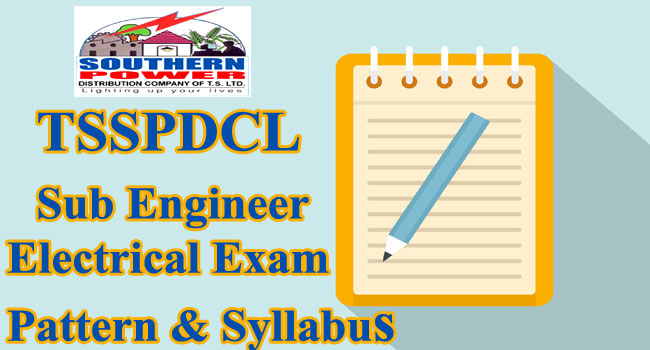TSSPDCL Sub Engineer Electrical Exam Pattern & Syllabus

Scheme of Examination for TSSPDCL Sub Engineer Electrical
The written test comprising of 100 marks consisting of 100 multiple choice questions and each question carrying 1 mark. The Section A consisting of 80 questions on core technical subject and the Section B consisting of 20 questions on General Awareness and Numerical Ability and History related to Telangana Culture & Movement. The duration of the written examination will be 2 hrs. (120 minutes)
TSSPDCL Sub Engineer Electrical Syllabus for Written Examination
UNIT 1: Basic Electrical Engineering
- Ohms law and Kirchhoff’s laws, Star/Delta transformation, Network theorems, Power and Energy, Heating effects of electric current, Magnetic effects, Electromagnetic induction, Electrostatics. Batteries, Types of Electrical engineering materials – Conducting, Semi-conducting, Magnetic, Insulating, Di-electric materials – Properties and Uses.
UNIT II: D.C. Machines & Measurements
- D.C. Generators: Construction, Operation, Types, EMF Equation, Windings, Characteristics, Efficiency and Parallel operation.
- DC Motors: Principle of operation, Back EMF, Torque Equation, Types, Characteristics, Starters, Speed Control, Losses, Efficiency and Testing.
- Measuring Instruments: Classification, Principle &f Operation of Moving Coil, Moving Iron, Dynamometer type and Induction type meters. Instrument Transformers, Induction type Energy meter, M.D. Indicator, Tri Vector Meter, Power factor meter, Frequency meter, Measurement of Resistance, Transducers and Sensors – Types, Thermistor, Thermo-couple, Pressure Transducers and Strain gauges, Working of Cathode ray oscilloscope
UNIT III: A.C. Circuits and Transformers
- A.C. Circuits: Fundamentals, Series and parallel R-L-C Circuits, Resonant circuits, Three-phase circuits, Measurement of power by two Wattmeters.
- Transformers: Single-phase Transformer, Construction, Operation, Equivalent circuit, Regulation, Efficiency, Testing and parallel operation, Three-phase transformer, Auto-transformer
UNIT IV: A.C. Machines
- Alternators: Construction, Operation, EMF equation, regulation, testing and parallel operation.
- Synchronous Motors: Operation and performance, Effects of excitation, V - Curve and inverted V - Curve, Methods of starting and uses.
- Three-Phase induction Motors: Construction, Principle of Operation, Torque Equation, Slip-torque characteristics, Losses & efficiency, Speed control, Starters, Double-cage motor.
- Single-phase Motors: Types, Principle of operation, characteristics and applications of induction motors and commutator motors
UNIT V: Power System Generation & Protection
- Generating Stations: Working components, Comparison of Thermal, Hydel, and Nuclear stations, Pollution control, Combined Working, Power Station auxiliaries, Characteristic Curves and Important definitions, Types of tariffs, Power factor correction and economy.
- Power Systems Protection: Circuit Breakers - Types, Principles of operation and uses. Current Limiting reactors, Relays – Classification, Principle of Operation of Induction type over current relay, Directional and Non-directional relays, Differential relays and Distance relays, Protection of Alternations, Transformers, Bus-bars, Transmission lines, Lightening arrestors, Neutral grounding.
UNIT VI: Transmission and Distribution
- Transmission: Types of supply systems, Transmission Line parameters, inductance and capacitance, performance of short and medium lines, regulation, Ferranti effect, Corona, Basic concepts of HVDC Transmission, Advantages and disadvantages of HVDC Transmission.
- Components of lines, supports, conductor spacing, ground clearance and sag, insulators, voltage distribution across the string, string efficiency, methods of improving string efficiency, Earthing and layout of sub-stations.
- Cables – Classification, insulation resistance, specifications,
- Distribution – Radial and ring type distributions, variation of load voltage,
UNIT VII: Utilization and Electric Drives
- Lighting: Laws of Illumination, Types of Lamps, Lighting Schemes for indoor, outdoor, street and factory.
- Heating and Welding: Principles and application of different resistance heating, direct and indirect arc furnaces, core and core-less induction furnaces, di-electric heating, Welding generators & welding transformers.
- Electric Traction: Systems of Train Electrification, Speed-time Curves for different services, Schedule speed, Tractive Effort, Specific Energy Consumption, Traction system auxiliaries, Traction motors.
- Electric Drives: Different Types, nature of load, Rating of motors, Types of enclosures, Motors for different drives. Electric Braking - Dynamic braking and Counter-current braking of dc motors and 3-phase induction motors.
UNIT VIII: Electrical Estimation and Automation
- Electrical Wiring: Tools, Wires, Types of wiring, Accessories, Lamp Circuits, Estimating and Costing of domestic, industrial power, irrigation pump sets, Rural electrification, departmental tests, earthing.
- Automation: Basics of control system, Basic principles of Programmable Logic controller (PLC), Parts of PLC, Simple applications with PLC.
UNIT IX: Basic Electronics and Digital Electronics
- Semi-Conductor Devices: N Type & P type, Zener diode, PNP and NPN Transistors, Transistor configurations, input and output characteristics, power supplies – half wave and full wave rectifiers. Filters, Zener diode, regulation, Special devices-UJT, FET, LED, SCR, Opto-Coupler, Photo diode, Photo Transistor.
- Amplifiers: Types, Principles of operation, Characteristics RC coupled, Transformer coupled and Direct coupled amplifiers. Class A amplifiers, Pushpull amplifiers, Feed-back, Difference and Operational amplifiers Oscillators and Electronic Testers, Function Generators, Industrial application of timers, Basics of IC’s.
- Digital Electronics: Different numbering systems, Inter Conversions, Boolean Algebra, Logic families, Performance of AND, OR, NOT, NOR, NAND gates, Combinational logic circuits, Sequential logic circuits, Registers and Memories, A/D and D/A converters.
UNIT X: Power Electronics and Micro Controller
- Power Electronic Devices: Construction and working of SCR, GTO, DIAC, TRIAC, Volt-ampere characteristics, Trigging of SCR using UJT Protection
- Convertors: Types of Phase-controlled Convertors, Working of AC regulators and Choppers. Types & basic principle of working of Inverters and Cycloconvertors.
- Speed control: Speed control of D.C. Motors using convertors and choppers, Speed control of induction motor using AC Voltage regulators and V/f Control, Switched mode power supplies (SMPS), UPS.
- Micro-Controllers: Architecture and Instruction set of 8051, Programming concepts, peripheral IC’s – Function, features, Pin details and interfacing of 8255,8251, 8279, 8257, 8259, RS-232.
Section-B: 20 Marks.
General Awareness and Numerical Ability:
- Analytical & Numerical Ability
- General Awareness
- English
- Related to Telangana Culture & Movement
- Computer Knowledge
Also Check:
70 AE Posts at TSSPDCL | Check Eligibility, Exam Pattern & Syllabus Here!!
Recruitment Notification for 2065 Phase X Selection Posts at SSC | Check Exam Pattern & Syllabus Here!!
922 Non Executives Posts at ONGC









